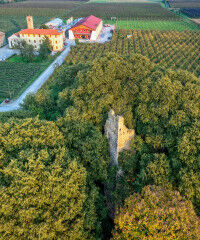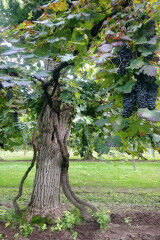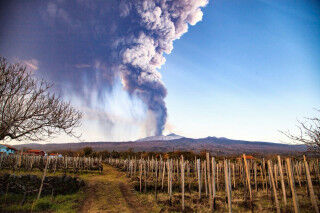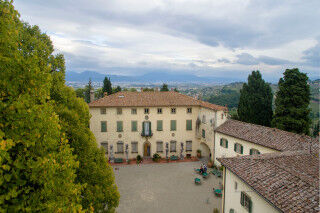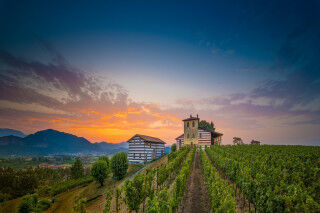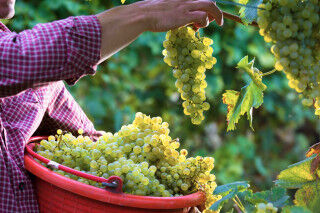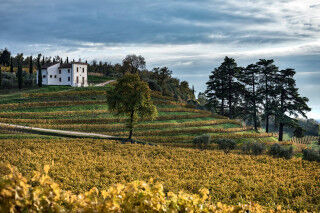THE PIAVE: A RIVER OF TREMENDOUS HISTORY
The Piave represents emblematically much more than just the “Sacred River of the Homeland,” going beyond the historical events that occurred on its banks during the First World War. For wine enthusiasts, it’s also indicative of immense vineyard expanses, spreading from each side of the river’s banks. These green vistas create a lasting impression of abundance, astonishing richness and vigorous development.
The Piave is an Alpine river that, particularly in the sweetest, almost Greek part of the Treviso region, “filters underground, and resurfaces, sparkling, everywhere in the countryside.” The Piave watercourse cuts the Veneto nearly in half, crossing the region from north to south. The river’s path highlights its most artistic, balanced, and graceful side, where lights and colors act as protagonists throughout the year and where the rules of wine-making are followed and adapted to create a memorable wine, the Malanotte DOCG that we’ll explore below.
VINES AND MANKIND: THE BELLUSSERA VITICULTURAL TECHNIQUE’S FUNDAMENTAL PASSAGE
In his groundbreaking tome, The Five Senses (1985), French philosopher Michele Serres searches for a link between exact science and human sciences. This narrow path is difficult to imagine. In searching for the link between the selection and cultivation of specific vine varieties in the past, and the reasons that defined these selections, we find similarities between the notion of biological phenomena and the culture that tried to define them.
The problem, Serra continues, is complexity. This complexity characterizes a system in which the number of elements and the number of interacting links is immensely large.
The Bellussera method masterfully expresses a final concept of industriousness, thanks to the ancient, fertile bond between vines and man, transforming itself into a most exceptional landscape.
The Bellussera cultivation technique was born from the intuition and determination of the Bellussi brothers at the end of 19th century. In the small town of Tezze di Piave, the Bellussi brothers combined innovative material use (iron wires) with the production needs of sharecropping families.
This cultivation process proved the exemplary functionality of the grape vines, and their ability to adapt to extremely variable environments and climates.
Climatic concerns were also considered in this cultivation process, in the form of following late frosts as vines are located on the plain, as well as labor concerns via manpower resources, and vine health through the presence of vine diseases imported from the New World. Thanks to the success of their vision, the Bellussi brothers found success as they created the first nearly pure vineyard system.
We find it true that viticulture must first of all begin from a specific project, a notion further confirmed in recent years. This project or vision can be solely viti-enological at its base, and can include boundaries beyond the scope of wine-production. These ambitions can continue further, encompassing the world of international wine markets and marketing projects of wine.
Every viticulturist getting into the wine-making business must find their own path as they approach wine-creation. This logic applies to the creation of the Bellussi philosophy, where their cultivation process “fits like a glove,” thanks to their selection of the time’s best vineyard cultivation techniques. At their heart, finding the ideal solution is also a question of careful attention to local environments, human health, and occasionally, costs. More often than not, costs are secondary considerations however.
What is the Bellussera method? An ingenious architectural approach to vine cultivation that follows the needs of the vineyards in the plains. In this unusual technique, four vines are radially arranged around a single mulberry tree (popular in the 19th century gardening circles), or around a defunct wooden pole. Coming out of this wooden base, three individual rows of galvanized wires unfurl, each with a different thickness, and all arranged on the same vertical alignment.
In short, we find a truly spatial reticular structure in perfect statis equilibrium, weighted down by a separate force inducing pressure from the top to bottom of the structure. This structural feature eliminates the natural need for spiders, with their web of threads, and where the suspended garden of vine shoots continues today to amazing thanks for their impressive proportions.
RABOSO PIAVE: A MYSTERIOUS AND SEDUCTIVE WINE
The Bellussera technique therefore describes an active example of historic identity and culture based in local viticulture of the Piave river area. What grape varieties can we find grown following this method? To name one, we can begin with the Raboso Piave grape.
To quote Mario Soldati, in his masterpiece “Vino al Vino,” (Mondadori 1969):
"Raboso is a wine full of mystery. Perhaps the secret is in the soil: in those gravely soils of the Piave, that is, in those ancient gravel banks, in those floodplains between the river and its banks, where the vines are cultivated, and where the grapes ripen under a blazing sun, in the air of the nearby sea."
This wine and grape perhaps finds its name explained as an “angry” reaction to the wine’s impact, both sour and astringent, that both the wine and grape’s flavor and processing have on the palate.
Indeed, the majority of consumers still are ignorant to the benefits of the wine’s aging potential. When aged, the wines’ sharp acidity and strong tannins are expressed, and help make this wine one to remember.
We find three wonderful interpreters of the Malanotte DOCG wine, all of whom lead us on Pindaric journeys of wine-based gustatory charm, revealing several different expressions of style and evolution.
First, we encounter the Ca' di Rajo winery’s Malanotte DOCG Notti di Luna Piena 2013, a wine that not only reflects 100% Bellussi principles, but that blends elegance and softness in quasi-perfect harmony.
The Malanotte DOCG UNNO 2010 produced by the Antonio Facchin wine estate is a combination of Bellussi and Capovolto viticultural practices. This wine instead highlights the grapes’ exquisite Balsamic bouquet and pairs stunningly with a fine, spice-accented flavor.
Finally, the De Stefani wine estate has produced a Malanotte DOCG 2015 that utilizes the Guyot technique thanks to the clay-heavy soils and their elevated anthocyanin potential. This wine brings a great fruitiness to the table, with elements of cherry jam that result in an austere, decisive experience on the palate.
Learning all about fine Italian wines got your juices going? Start planning some travel to Italy to taste these fine wines in person - for more inspiration, follow Filippo Bartolotta as he explores the Sicilian Mt. Etna area, Eastern Sicily’s Etna Wines take on the Wine World. Don’t forget about Tuscany: a stroll through the miraculous lands of Montalcino, in his Miracle of Montalcino video series.
Subscribe below to our newsletter and stay updated!


